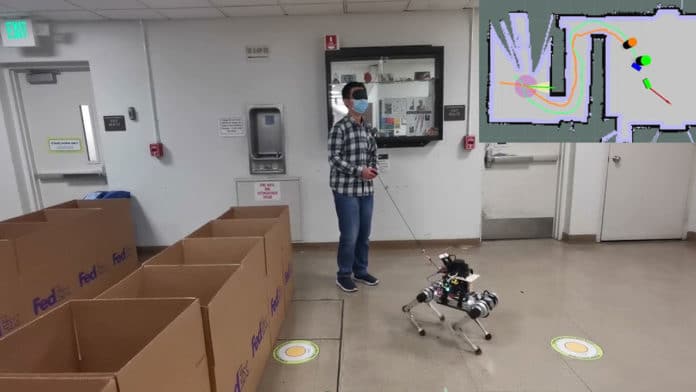Guide dogs play a critical role in our society by helping the frail, elderly, or visually impaired people navigate the world. However, a well-behaved guide dog usually needs to be selected and trained individually. In addition, the skills from one dog cannot be transferred to another one. This makes training guide dogs both time and labor-intensive, with the process not easily scalable. With recent progress in robotics, an autonomous robot could potentially take over this responsibility.
A team of scientists from the University of California, Berkeley, has developed a four-legged, dog-like robot to safely guide people with a lead, even when faced with obstacles and narrow passages. The Robotic Guide Dog can navigate visually impaired people far more effectively than a flesh and blood dog ever could. At least, that is what its creators are convinced of.
As a hardware platform, they used the Mini Cheetah four-legged robot, created by their colleagues at the Massachusetts Institute of Technology. The robot is equipped with a laser-ranging system to create an accurate map of its surroundings and a camera to track the human it is guiding.
The Robotic Guide Dog will use a guiding software that is automatically downloaded into the machines and can be updated over time, according to the project leader Zhongyu Li.
“Using a robotic guide dog, we can directly deploy our code from one robot to another,” Li told New Scientist. “As time goes by and the hardware becomes more affordable, we can actually use this kind of dog to help, to serve, humans.”
There’s still work to be done before the robots are ready to hit the streets. But at the moment, as is impressively demonstrated by a video, they can already keep an eye on their master while steering them autonomously around obstacles using lasers.
Mr. Li and colleagues tested the bot guiding three blindfolded people around an obstacle course the included narrow section less than three feet across – and they reported that it proved successful in each instance.
However, guide dog owners are unlikely to build the same rapport with a robot that they do with their flesh and blood companions, Tim Stafford from the UK charity Guide Dogs told New Scientist. “They value their dog as a partner, companion, and family member, as well as a guide dog,” Stafford said. “It is this deep bond that makes the relationship unique and so much more than just a way to get around safely.“
In the future, the team imagines people being able to sync their computer or smartphone calendars with the robot. And using GPS, the guide robodog could help visually impaired people actively navigate from one place to another. A real dog can never do that.
An article on development will be presented at the ICRA 2021 conference and is available as a preprint on the arXiv repository.
